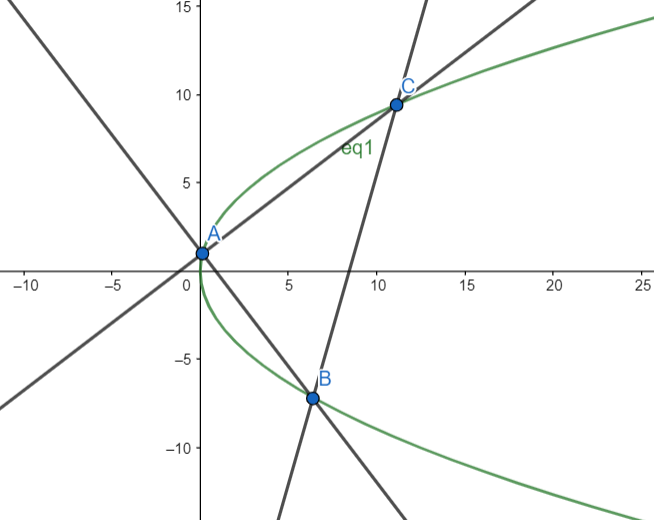
Answer
461.7k+ views
Hint: We will be using the concepts of parabola and coordinate geometry to solve the problem. We will be using the equation of the parabola and the y-coordinates given in the question to find the vertices of the triangle then we will use the formulae for finding the area of the triangle in coordinate geometry.
Complete step by step answer:
Now, we have been given a parabola ${{y}^{2}}=8x$. Also, we have been given ordinates of the vertices of triangles inscribed by the parabola. So, we have,
${{y}_{1}}=1,{{y}_{2}}=3,{{y}_{3}}=4$

Now, since the points lie of ${{y}^{2}}=8x$ Therefore, we will use the equation of parabola to find the subsequent x-coordinates. So,
$\begin{align}
& \Rightarrow {{y}_{1}}^{2}=8{{x}_{1}} \\
& \Rightarrow {{1}^{2}}=8{{x}_{1}} \\
& \Rightarrow \dfrac{1}{8}={{x}_{1}} \\
& \Rightarrow {{y}_{2}}^{2}=8{{x}_{2}} \\
& \Rightarrow \dfrac{9}{8}={{x}_{2}} \\
& \Rightarrow {{y}_{3}}^{2}=8{{x}_{3}} \\
& \Rightarrow \dfrac{16}{8}={{x}_{3}} \\
& \Rightarrow 2={{x}_{3}} \\
\end{align}$
So, the vertices of triangle are;
$\left( \dfrac{1}{8},1 \right)\left( \dfrac{9}{8},3 \right)\left( 2,4 \right)$
Now, we know that area of triangles with $\left( {{x}_{1}},{{y}_{1}} \right)\left( {{x}_{2}},{{y}_{2}} \right)\left( {{x}_{3}},{{y}_{3}} \right)$ as vertices is;
$\begin{align}
& \Rightarrow \dfrac{1}{2}\left( {{x}_{1}}\left( {{y}_{2}}-{{y}_{3}} \right)+{{x}_{2}}\left( {{y}_{3}}-{{y}_{1}} \right)+{{x}_{3}}\left( {{y}_{1}}-{{y}_{2}} \right) \right) \\
& Area=\dfrac{1}{2}\left( \dfrac{1}{8}\left( 3-4 \right)+\dfrac{9}{8}\left( 4-1 \right)+2\left( 1-3 \right) \right) \\
& \Rightarrow \dfrac{1}{2}\left( \dfrac{1}{8}\left( -1 \right)+\dfrac{9}{8}\left( 3 \right)+2\left( -2 \right) \right) \\
& \Rightarrow \dfrac{1}{2}\left( \dfrac{-1}{8}+\dfrac{27}{8}-4 \right) \\
& \Rightarrow \dfrac{1}{2}\left( \dfrac{-1+27-32}{8} \right) \\
& \Rightarrow \dfrac{-33+27}{16} \\
& \Rightarrow \dfrac{-6}{16} \\
& \Rightarrow \dfrac{-3}{8} \\
\end{align}$
Since, the area can’t be negative therefore the area is $\dfrac{3}{8}$ .
So, the correct answer is “Option B”.
Note: To solve these type of question it is important to remember the concepts of parabola and coordinate geometry also the question can be solved alternatively as;
\[\begin{align}
& Area=\dfrac{\left( {{y}_{1}}-{{y}_{2}} \right)\left( {{y}_{2}}-{{y}_{3}} \right)\left( {{y}_{3}}-{{y}_{1}} \right)}{8a} \\
& \Rightarrow \dfrac{\left( 1-3 \right)\left( 3-4 \right)\left( 4-1 \right)}{8\times 2} \\
& \Rightarrow \dfrac{3}{8} \\
\end{align}\]
Complete step by step answer:
Now, we have been given a parabola ${{y}^{2}}=8x$. Also, we have been given ordinates of the vertices of triangles inscribed by the parabola. So, we have,
${{y}_{1}}=1,{{y}_{2}}=3,{{y}_{3}}=4$

Now, since the points lie of ${{y}^{2}}=8x$ Therefore, we will use the equation of parabola to find the subsequent x-coordinates. So,
$\begin{align}
& \Rightarrow {{y}_{1}}^{2}=8{{x}_{1}} \\
& \Rightarrow {{1}^{2}}=8{{x}_{1}} \\
& \Rightarrow \dfrac{1}{8}={{x}_{1}} \\
& \Rightarrow {{y}_{2}}^{2}=8{{x}_{2}} \\
& \Rightarrow \dfrac{9}{8}={{x}_{2}} \\
& \Rightarrow {{y}_{3}}^{2}=8{{x}_{3}} \\
& \Rightarrow \dfrac{16}{8}={{x}_{3}} \\
& \Rightarrow 2={{x}_{3}} \\
\end{align}$
So, the vertices of triangle are;
$\left( \dfrac{1}{8},1 \right)\left( \dfrac{9}{8},3 \right)\left( 2,4 \right)$
Now, we know that area of triangles with $\left( {{x}_{1}},{{y}_{1}} \right)\left( {{x}_{2}},{{y}_{2}} \right)\left( {{x}_{3}},{{y}_{3}} \right)$ as vertices is;
$\begin{align}
& \Rightarrow \dfrac{1}{2}\left( {{x}_{1}}\left( {{y}_{2}}-{{y}_{3}} \right)+{{x}_{2}}\left( {{y}_{3}}-{{y}_{1}} \right)+{{x}_{3}}\left( {{y}_{1}}-{{y}_{2}} \right) \right) \\
& Area=\dfrac{1}{2}\left( \dfrac{1}{8}\left( 3-4 \right)+\dfrac{9}{8}\left( 4-1 \right)+2\left( 1-3 \right) \right) \\
& \Rightarrow \dfrac{1}{2}\left( \dfrac{1}{8}\left( -1 \right)+\dfrac{9}{8}\left( 3 \right)+2\left( -2 \right) \right) \\
& \Rightarrow \dfrac{1}{2}\left( \dfrac{-1}{8}+\dfrac{27}{8}-4 \right) \\
& \Rightarrow \dfrac{1}{2}\left( \dfrac{-1+27-32}{8} \right) \\
& \Rightarrow \dfrac{-33+27}{16} \\
& \Rightarrow \dfrac{-6}{16} \\
& \Rightarrow \dfrac{-3}{8} \\
\end{align}$
Since, the area can’t be negative therefore the area is $\dfrac{3}{8}$ .
So, the correct answer is “Option B”.
Note: To solve these type of question it is important to remember the concepts of parabola and coordinate geometry also the question can be solved alternatively as;
\[\begin{align}
& Area=\dfrac{\left( {{y}_{1}}-{{y}_{2}} \right)\left( {{y}_{2}}-{{y}_{3}} \right)\left( {{y}_{3}}-{{y}_{1}} \right)}{8a} \\
& \Rightarrow \dfrac{\left( 1-3 \right)\left( 3-4 \right)\left( 4-1 \right)}{8\times 2} \\
& \Rightarrow \dfrac{3}{8} \\
\end{align}\]
Recently Updated Pages
Who among the following was the religious guru of class 7 social science CBSE

what is the correct chronological order of the following class 10 social science CBSE

Which of the following was not the actual cause for class 10 social science CBSE

Which of the following statements is not correct A class 10 social science CBSE

Which of the following leaders was not present in the class 10 social science CBSE

Garampani Sanctuary is located at A Diphu Assam B Gangtok class 10 social science CBSE

Trending doubts
A rainbow has circular shape because A The earth is class 11 physics CBSE

Fill the blanks with the suitable prepositions 1 The class 9 english CBSE

Which are the Top 10 Largest Countries of the World?

How do you graph the function fx 4x class 9 maths CBSE

The Equation xxx + 2 is Satisfied when x is Equal to Class 10 Maths

Give 10 examples for herbs , shrubs , climbers , creepers

Change the following sentences into negative and interrogative class 10 english CBSE

Difference between Prokaryotic cell and Eukaryotic class 11 biology CBSE

Why is there a time difference of about 5 hours between class 10 social science CBSE




